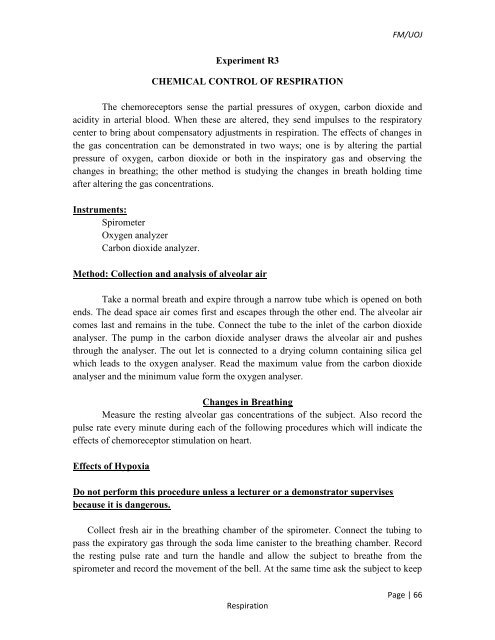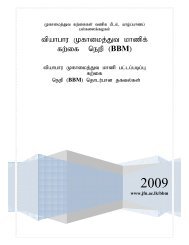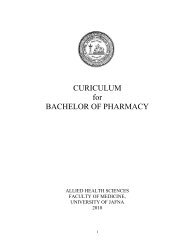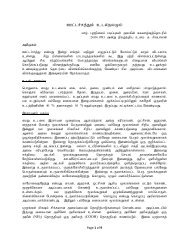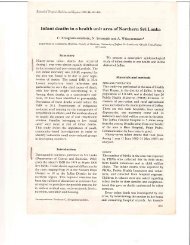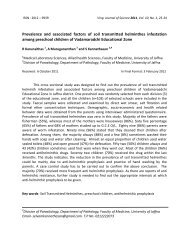MANUAL PHYSIOLOGY PRACTICAL - Repository:The Medical ...
MANUAL PHYSIOLOGY PRACTICAL - Repository:The Medical ...
MANUAL PHYSIOLOGY PRACTICAL - Repository:The Medical ...
Create successful ePaper yourself
Turn your PDF publications into a flip-book with our unique Google optimized e-Paper software.
FM/UOJ<br />
Experiment R3<br />
CHEMICAL CONTROL OF RESPIRATION<br />
<strong>The</strong> chemoreceptors sense the partial pressures of oxygen, carbon dioxide and<br />
acidity in arterial blood. When these are altered, they send impulses to the respiratory<br />
center to bring about compensatory adjustments in respiration. <strong>The</strong> effects of changes in<br />
the gas concentration can be demonstrated in two ways; one is by altering the partial<br />
pressure of oxygen, carbon dioxide or both in the inspiratory gas and observing the<br />
changes in breathing; the other method is studying the changes in breath holding time<br />
after altering the gas concentrations.<br />
Instruments:<br />
Spirometer<br />
Oxygen analyzer<br />
Carbon dioxide analyzer.<br />
Method: Collection and analysis of alveolar air<br />
Take a normal breath and expire through a narrow tube which is opened on both<br />
ends. <strong>The</strong> dead space air comes first and escapes through the other end. <strong>The</strong> alveolar air<br />
comes last and remains in the tube. Connect the tube to the inlet of the carbon dioxide<br />
analyser. <strong>The</strong> pump in the carbon dioxide analyser draws the alveolar air and pushes<br />
through the analyser. <strong>The</strong> out let is connected to a drying column containing silica gel<br />
which leads to the oxygen analyser. Read the maximum value from the carbon dioxide<br />
analyser and the minimum value form the oxygen analyser.<br />
Changes in Breathing<br />
Measure the resting alveolar gas concentrations of the subject. Also record the<br />
pulse rate every minute during each of the following procedures which will indicate the<br />
effects of chemoreceptor stimulation on heart.<br />
Effects of Hypoxia<br />
Do not perform this procedure unless a lecturer or a demonstrator supervises<br />
because it is dangerous.<br />
Collect fresh air in the breathing chamber of the spirometer. Connect the tubing to<br />
pass the expiratory gas through the soda lime canister to the breathing chamber. Record<br />
the resting pulse rate and turn the handle and allow the subject to breathe from the<br />
spirometer and record the movement of the bell. At the same time ask the subject to keep<br />
Respiration<br />
Page | 66


